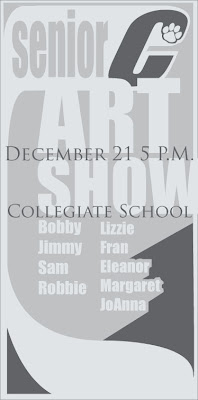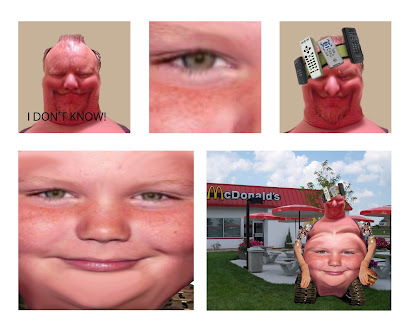So far, I have been making a relatively simple animation out of blue lines. I spelled out my name, animating the letters as the name was spelled out. The M, at one point, turns into a bird, which regurgitates a worm for the rest of my name, which becomes the final A, and then the last two L's are spelled out, sort of like little wings. Those flap a bit, and then the swoop on the H in my name turns into a ghost, and swallows up the whole name. The ghost transforms into a blobby little creature, which catches a mysterious egg which rolls by into his hand. Then the egg rolls away from the creature's hand (the creature has turned into a "P" and walks off stage right) and hatches. The creature that hatches from the egg quickly grows into a bigger creature, and a porkpie hat falls from te sky onto his head. Just as the hat hits his head, a can thrown from stage right lands in his right hand, which he twirls once.
I made this in FLASH 8. I should say that Flash 8 is a pretty daunting program, at least on the face of it. I was fairly intimidated, since I got this program- how did it work?? I had some friends who are fairly well versed in it, so I took advantage of that.
Basically, what I have done is to set up my interface to be as similar to a traditionaly analog setup- a flipbook. I make a separate layer for each element of the animation. Anyone familiar with movie editing computer programs such as iMovie, or audio editing programs such as GarageBand or Logic should have a fairly good idea of the intuitive process involved in creating a work of art according to a certain timeline. First, I set up my stage. I noted what size I wanted. I started off by making separate animations of separate letters start on separate layers. Layers, essentially, work in much the same fashion that layers work in Photoshop, or in Illustrator. Whatever is at the top layer usually overlays anything underneath it. Next, I did this: I decided how long the animation might be. I was guessing about 500 frames to begin with, so I clicked on the 500th frame, and went to INSERT>TIMELINE>FRAME. That set up a frame for me. Then, I inserted "KeyFrames" by MODIFY>TIMELINE>CONVERT TO KEYFRAMES. That sets up, virtually, a 500 (495 in my case)-page "flipbook" wherein I could advance through pages, slightly altering or building upon, progressively, each previous page. How did I see what I was doing when I got to the new page? Well, I selected something called "onion skins" in the prompt- it's one of the icons below the layer editor. That, essentially, makes each page, during editing, like tracing paper. You can edit how transparent the "tracing paper" is, as well. It's great. So I just did that, pretty much for 7 hours today, and came up with what you see of the video so far.
The video, or animation, will be a bit longer, and more involved, by the end of the semester. Expect me to win an oscar for it. An Oscar Mayer hotdog. Or expect me to eat lunch a lot while working on it.
The MOST IMPORTANT tool for me, when working on this, was the Bamboo tablet that I borrowed from the art dept. It was great.








